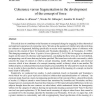100
click to vote
COGSCI
2004
15 years 12 days ago
2004
This paper surveys work on applying the insights of lexicalized grammars to low-level discourse, to show the value of positing an autonomous grammar for low-level discourse in whi...
COGSCI
2004
15 years 12 days ago
2004
105
Voted
COGSCI
2004
15 years 12 days ago
2004
Eighty-two participants listened to sentences and then judged whether two sequentially presented visual objects were the same. On critical trials, participants heard a sentence de...
91
Voted
COGSCI
2004
15 years 12 days ago
2004
In order to understand ongoing activity, observers segment it into meaningful temporal parts. Segmentation can be based on bottom-up processing of distinctive sensory characterist...
122
click to vote
COGSCI
2004
15 years 12 days ago
2004
When people engage in conversation, they tailor their utterances to their conversational partners, whether these partners are other humans or computational systems. This tailoring...
86
Voted
COGSCI
2004
15 years 12 days ago
2004
We adapted the Bubbles procedure [Vis. Res. 41 (2001) 2261] to examine the effective use of information during the first 282 ms of face identification. Ten participants each viewe...
78
Voted
COGSCI
2004
15 years 12 days ago
2004
It is easy to construct pairs of sentences X, Y that lead many people to ascribe higher probability to the conjunction X-and-Y than to the conjuncts X, Y. Whether an error is ther...
102
Voted
COGSCI
2004
15 years 12 days ago
2004
I show how a conversational process that takes simple, intuitively meaningful steps may be understood as a sophisticated computation that derives the richly detailed, complex repr...
105
Voted
COGSCI
2004
15 years 12 days ago
2004
Four different kinds of grammars that can define crossing dependencies in human language are compared here: (i) context sensitive rewrite grammars with rules that depend on contex...
116
click to vote
COGSCI
2004
15 years 12 days ago
2004
Previous research suggests that children can infer causal relations from patterns of events. However, what appear to be cases of causal inference may simply reduce to children rec...

